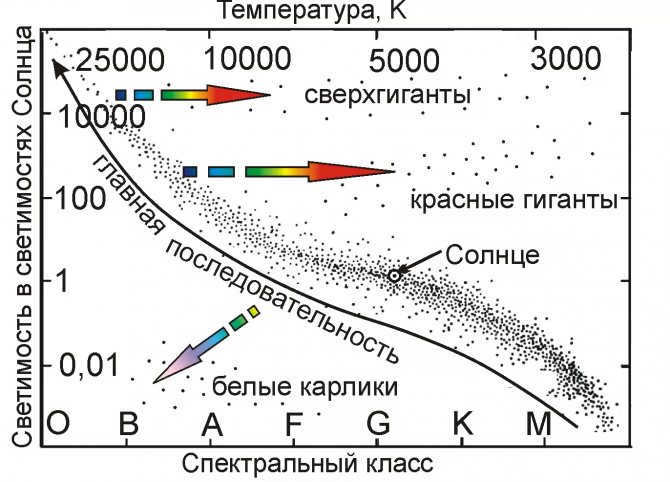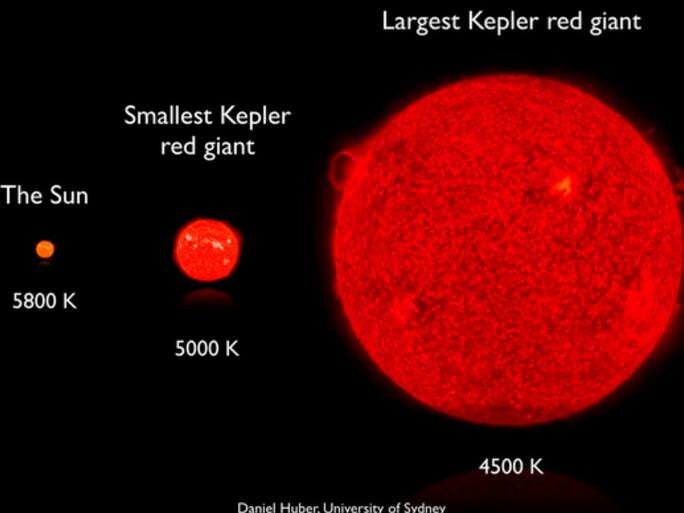Do you have knowledge about red giants? A red giant is a star that is in the process of dying. It is currently in the final stage of its stellar evolution. Red giants are typically classified as “main sequence stars”.
These stars undergo a transformation where hydrogen is converted into helium gas. Once the star has depleted all of its hydrogen fuel, it reaches the end of its life cycle. This progression can take billions of years. Red giants are more than 100 times larger than the Sun. Eventually, these main-sequence stars will transition into red giants and complete the final stage of their stellar evolution.
White dwarfs are another type of common star found in the vast Universe.
Massive stars that are hundreds of millions of kilometers in diameter are known as red giants. These stars can have a color that ranges from orange to red. The temperature on the surface and in the outer atmosphere of a red giant can vary from 4000° to 5800° F (2204° to 3204° C). Red giants can be classified into different classes such as class G, class K, class N, class M, carbon stars, and others. Our Sun, for example, belongs to class G. Other examples of red giants include Cacrux (class M), Arcturus (class K), Aldebaran, Hamal, Mira, and many more. Many of these red giants are located in the outer solar system.
As the Sun expands in size, the presence of liquid water on Earth will evaporate, signifying the cessation of life and the disappearance of the habitable zone.
Upon acquainting oneself with the duration of a star’s transition into a red giant, one should also acquaint oneself with the information regarding the puppeteer and the rock, composed of fused shells and coral.
Reasons behind the formation of red giant stars
Red giants are formed when main-sequence stars exhaust their hydrogen fuel through the process of nuclear fusion, converting it into helium gas. This depletion of hydrogen takes billions of years to occur.
As the hydrogen is converted into helium, energy is released, which sustains the star and prevents it from collapsing. However, once all the hydrogen is consumed, the star runs out of energy and begins to collapse. This collapse triggers a fiery reaction within the star. Now, helium atoms start to combine and form carbon.
This process also generates energy that prevents the collapse of the star. The external layers of the star are pushed outwards, resulting in the star expanding significantly. It has an orange or red hue and is referred to as a red giant. Following the red giant stage, it transitions into a white dwarf and ultimately ceases to exist.
Is it possible for our Sun to become a red giant?
The Sun is classified as a main-sequence star, which implies that it undergoes nuclear fusion, converting hydrogen into helium. Eventually, in approximately 5 billion years, it will transform into a red giant star. Once the red giant phase concludes, it will eventually perish after an additional 5 billion years.
The age of the sun is approximately 4.6 billion years. It serves as the primary source of energy for Earth and the other celestial bodies within the solar system. The long-term effects of its aging process on our planet remain uncertain, but it is likely that all life will cease to exist by then. The sun derives its energy from a nuclear fusion reaction, where hydrogen atoms are converted into helium atoms. Similar to other stars in the main sequence, the sun possesses a limited supply of hydrogen in its core, which will eventually deplete.
The duration of this process varies depending on the star’s size. In approximately 5 billion years, the sun will deplete its fuel and undergo a transformation into a red giant. Subsequently, it will contract into a white dwarf, followed by the formation of a planetary nebula, ultimately leading to its demise.
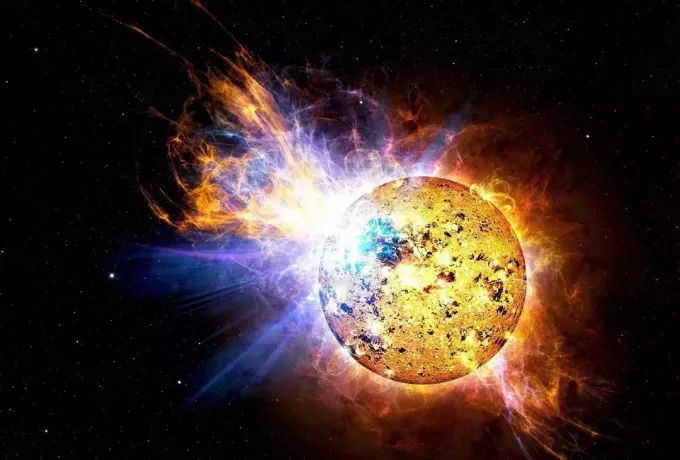
What happens when the Sun transforms into a red giant?
The ultimate fate of the Sun is its transformation into a red giant and subsequent death. This event is bound to happen, however, it is unlikely that we, as humans, will be around to witness it. By that time, we will have long vanished. The process of the Sun turning into a red giant is estimated to take approximately 5 billion years. As it progresses, its luminosity will intensify due to helium flaring, eventually leading to our disappearance in the distant future.
The Sun’s core is composed of hydrogen and has high surface temperatures. Through a process called nuclear fusion, the hydrogen is converted into helium. This fusion reaction generates energy, which counteracts the force of gravity and prevents the star from collapsing. However, the supply of hydrogen is limited. Once all the hydrogen is exhausted and converted into helium, the star undergoes a collapse due to the absence of energy to resist gravitational pull. During this collapse, the helium atoms fuse to form carbon atoms.
This fusion reaction produces energy, preventing the star from collapsing further. As a result, the star expands and becomes a red giant, exhibiting a red or yellow-orange color. The red giant grows in size and engulfs the planets orbiting around it.
What is the largest star in the universe?
It is widely acknowledged that the largest star in the universe is UY Scuti, a red hypergiant situated in the Shields constellation. In terms of volume, it surpasses the Sun by an astonishing factor of 5 billion.
UY Scuti’s radius is approximately 1,700 times that of the Sun, making it an incredibly massive and dying star.
German astronomers at the Bonn Observatory first detected UY Scuti in 1860. Upon subsequent observations, they noticed a significant increase in its brightness, leading to its classification as a variable star. A variable star refers to a star whose brightness fluctuates when viewed from Earth. UY Scuti has a pulsation period of 740 days.
As a red giant, UY Scuti is in the twilight of its existence, with only about 10% or a few million years of life remaining. Its impending demise is predicted to be accompanied by the explosion of over 100 supernovae.
The most massive stars include KW Sagitarii, V354 Cephel, and KY Cygni.
Here at Kidadl, we have meticulously prepared a plethora of fascinating family facts for everyone! If you enjoyed our suggestions on Red Giants: amazing facts about the solar system for children, why not check out the ancient Mesopotamian wheel or everything you’ve ever wanted to know about the incredible Andaman Sea Peninsula.
Copyright © 2022 Kidadle Ltd. All rights reserved.
Large, cold stars that have depleted their hydrogen in the core are plotted on the Hertzsprung-Russell diagram. These stars can be classified as brown dwarfs, white dwarfs, red dwarfs, subdwarfs, main sequence (or “dwarfs”), subgiants, giants, bright giants, supergiants, or hypergiants. Their absolute magnitude is represented by MV.
A red giant is a type of luminous giant star that occurs in the later stages of stellar evolution. It is characterized by its low to intermediate mass (approximately 0.3-8 solar masses) and its inflated and rarefied outer atmosphere, which results in a large radius and a surface temperature of around 5,000 K (4,700 °C; 8,500 °F) or lower. Red giants can appear yellow-orange to red in color, with spectral classes ranging from K and M to S and carbon stars.
Red giants can generate energy in different ways:
- The most common type of red giant is found on the red giant branch (RGB), where hydrogen is still being converted into helium in a shell surrounding an inert helium core.
- Another type of red giant, known as red clump stars, can be found on the colder half of the horizontal branch. These stars fuse helium into carbon in their cores through a process called the triple alpha process.
- AGB stars are characterized by a helium burning shell surrounding a degenerate carbon-oxygen core and a hydrogen burning shell just above it.
Red giants are well-known for their luminosity and relatively common occurrence. Arcturus, a K0 RGB star, is located 36 light-years away, while Gamma Crucis is the closest M-class giant, situated 88 light-years away.
- 1 Characteristics
- 2 Evolution
- 2.1 Stars that do not undergo red giant phase
- 3.1 Prospects for habitability
- 3.2 Increase in planetary systems
- 4.1 Branching of red giants
- 4.2 Giants with red clumps
- 4.3 Asymptotic branching of giants
Features
Mira, a type of variable asymptotic giant branch star, is classified as a red giant.
A red giant is a type of star that has depleted its hydrogen fuel in its core and has started fusing hydrogen in the shell surrounding the core. These stars have radii that are tens or hundreds of times larger than the Sun. However, their outer shells have a lower temperature, giving them a reddish-orange hue. Despite having a lower energy density in their envelopes, red giants are much brighter than the Sun due to their large size. Red giant branch stars have luminosities that are nearly three thousand times greater than the Sun (L ☉), with spectral classes K or M, surface temperatures ranging from 3000-4000 K, and radii about 200 times that of the Sun (R ☉). Stars on the horizontal branch are hotter, with a narrower range of luminosities of about 75 L ☉. Asymptotic giant branch stars have a luminosity that can be similar to the brighter stars of the red giant branch or several times brighter at the end of the thermal pulse phase.
The appearance of a red giant’s stellar limb is not clearly defined, in contrast to how it is often depicted in illustrations. This is due to the extremely low mass density of the envelope surrounding these stars, which results in a lack of a well-defined photosphere. Instead, the body of the star gradually transitions into a “corona”. The spectra of the coolest red giants are quite complex, exhibiting molecular lines, emission elements, and occasionally masers, particularly in thermally pulsating AGB stars. Observations have also provided evidence for the existence of hot chromospheres above the photosphere of red giants. Understanding the mechanisms responsible for the formation of these chromospheres requires the use of three-dimensional modeling of red giants.
One distinguishing characteristic of red giants is that, unlike stars similar to the Sun that have numerous small convection cells in their photospheres (known as solar granules), red giants and red supergiants have only a small number of large cells. These unique features are responsible for the frequent fluctuations in brightness observed in both types of stars.
Evolution
Evolution is a process that involves changes in the inherited characteristics of biological populations over successive generations. It is the driving force behind the diversity of life on Earth. Evolution occurs through a combination of genetic variation, heredity, and natural selection. Over time, these processes lead to the development of new species and the extinction of others. The study of evolution helps us understand the history and interconnectedness of all living organisms. It is a complex and ongoing field of scientific research.
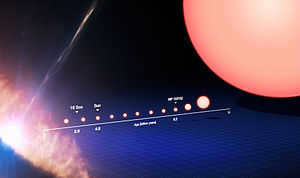
The picture depicts the journey of a star similar to the Sun, starting from its inception on the left side of the image and progressing into a red giant on the right side over the course of billions of years.
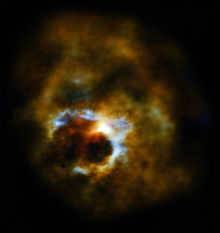
Mira A is a mature star that is currently ejecting its outer layers into the surrounding space.
The red giant branch is influenced by the mass of a star, determining its evolutionary path. For stars smaller than approximately 2 M ☉, the core will reach a level of density where electron degeneracy pressure prevents further collapse. As the core degenerates, it will continue to heat until it reaches a temperature of around 10 K, which is sufficient to initiate helium-carbon fusion through the triple-alpha process. Once the degenerate core reaches this temperature, helium fusion will begin almost simultaneously, resulting in a phenomenon known as a helium flash. In more massive stars, the core will reach 10 K before becoming dense enough to degenerate, resulting in a smoother initiation of helium fusion that does not cause a helium flash. The phase of a star’s life where helium fusion occurs in the core is referred to as the horizontal branch for metal-poor stars, as these stars are located on a nearly horizontal line on the H-R diagram of various star clusters. Conversely, metal-rich stars that undergo helium fusion are situated on the so-called red clot in the H-R diagram.
When the central helium is exhausted and the star collapses again, the helium in the shell begins to fuse. Simultaneously, hydrogen can start fusing in the envelope just behind the burning helium envelope. This places the star on the asymptotic branch of giants, which is the second phase of red giants. Carbon-oxygen core is produced through helium fusion. A star with a mass below 8 M ☉ will never initiate fusion in its degenerate carbon-oxygen core. Instead, at the end of the asymptotic giant branch phase, the star will expel its outer layers, forming a planetary nebula with the core of the star exposed, eventually transforming into a white dwarf. The ejection of the outer mass and the creation of the planetary nebula ultimately completes the red giant phase in the star’s evolution. The red giant phase typically lasts approximately one billion years for a star with a solar mass, with nearly all of it spent on the red giant branch. The horizontal branch and asymptotic giant branch phases occur at a much faster rate, many times over.
If a star has a mass between 0.2 and 0.5 M ☉, it is considered to be sufficiently massive to evolve into a red giant, but it does not possess enough mass to trigger the fusion of helium. These stars, classified as “intermediate”, undergo a cooling process and experience an increase in their brightness, but they never reach the peak of the red giant branch and exhibit a flash of a helium core. Once the ascent along the red giant branch concludes, these stars shed their outer layers, resembling post-asymptotic giant branch stars, and eventually transform into white dwarfs.
Stars that avoid becoming red giants
There are certain stars in the universe that manage to avoid the fate of becoming red giants. Instead of expanding and becoming unstable, these stars remain relatively stable throughout their lifecycle.
One reason why some stars don’t become red giants is because of their mass. Stars that have a mass less than about 0.4 times that of the Sun don’t have enough mass to initiate the fusion process that leads to becoming a red giant. These stars, known as low-mass stars, will eventually exhaust their fuel and fade away as white dwarfs.
Another reason why some stars don’t become red giants is due to their composition. Stars that are composed primarily of helium, such as helium white dwarfs, don’t have the necessary elements to undergo the fusion reactions that result in becoming a red giant.
Finally, some stars avoid becoming red giants due to their unique evolutionary paths. These stars may have undergone certain processes during their formation that prevent them from ever reaching the red giant phase.
Overall, while most stars in the universe will eventually become red giants, there are some stars that manage to avoid this fate and maintain their stability throughout their lifetime.
Very small stars have a complete convection and can convert hydrogen into helium for a trillion years, as long as a small part of the entire star consists of hydrogen. The luminosity and temperature gradually increase during this period, similar to more massive main-sequence stars, but in this case, the temperature eventually rises by approximately 50% and the luminosity increases by a factor of about 10. Eventually, the helium levels rise to a point where the star is no longer completely convective, and the remaining hydrogen trapped in the core is consumed in just a few billion years. Depending on the mass, the temperature and luminosity continue to increase for a while as the hydrogen shell burns, causing the star to become hotter than the Sun and tens of times brighter than when it initially formed, although not as bright as the Sun. After a few billion more years, they start to become dimmer and cooler, even though the burning of the hydrogen shell persists. They transform into cold helium white dwarfs.
Planets
There are several red giants that are known to have planets, such as the M-type HD 208527, HD 220074, and a few dozen known K-giants including Pollux, Gamma Cephei, and Iota Draconis, as of February 2014.
Possibilities for the Existence of Life
While it has traditionally been assumed that when a star evolves into a red giant, its planetary system, if it has one, would become unsuitable for life, some studies suggest that during the evolution of a star with a mass of 1 M ☉ along the red giant branch, there could be a habitable zone that lasts for several billion years. This habitable zone would be located at 2 astronomical units (a.u.) for approximately 100 million years, and then at 9 a.u. for around 9 million years, providing enough time for life to potentially evolve on a suitable planet. After the red giant stage, this star would still have a habitable zone that spans from 7 to 22 a.u. for an additional one billion years. Recent studies have further refined this scenario, demonstrating that for a star with a mass of 1 M ☉, the habitable zone can last anywhere from 100 million years for a planet with an orbit similar to Mars, to 210 million years for a planet orbiting at a distance equivalent to Saturn’s orbit around the Sun. The maximum amount of time, 370 million years, is reserved for planets orbiting at the same distance as Jupiter. However, if planets were to orbit a star with a mass of 0.5 M ☉ at the same distance as Jupiter and Saturn, they would remain within the habitable zone for 5.8 billion years and 2.1 billion years, respectively. For stars that are more massive than the Sun, the habitable zone is significantly shorter.
Formation of planets
By June 2014, about fifty giant planets had been detected in the vicinity of giant stars. However, these giant planets have a higher mass compared to the ones found around stars similar to our Sun. This could be because giant stars are generally more massive than the Sun (less massive stars would still be in the main sequence and have not yet evolved into giants), and it is expected that more massive stars would have more massive planets. Nevertheless, the masses of the planets discovered around giant stars do not directly correlate with the masses of the stars. This suggests that planets might accumulate mass during the red giant phase of the star. The increase in planet mass might be attributed partially to the accretion of material from the stellar wind. However, a more significant factor would be the overflow of the Roche cavity, leading to the transfer of mass from the star to the planet as the giant star expands to orbital distance.
Famous instances
A lot of the famous luminous stars are red giants since they are bright and quite prevalent. The closest M-class giant star on the variable red giant branch, Gamma Crucis, is located 88 light-years away. The red giants of the K0 Arcturus branch are situated 36 light-years from our position.
A division of red giants
Red clump giants
The asymptotic giant branch
The Sun’s transformation into a red giant
The current dimensions of the Sun (in its present main sequence state) compared to the projected maximum dimensions during its future red giant phase
In approximately 5 billion years, the Sun will exit the main sequence and undergo a transformation into a red giant. During this phase, the Sun will expand to such a size that it will engulf Mercury, Venus, and potentially even Earth.
Other resources
Check out the Red giants section on Wikimedia Commons for more media content related to this topic.


One of the most fascinating types of celestial bodies, without a doubt, are giant and supergiant stars. Let’s delve into what they are together.
Essentially, a giant star is a celestial body with a significant radius and intense luminosity. It’s worth mentioning that the total energy emitted by such objects can be 10-1000 times that of our Sun. Additionally, they have a size ranging from 10-100 times the radius of the Sun.

Interestingly, astronomer Einar Herzsprung was the one who introduced the names for various stars based on their luminosity. His work, along with Henry Russell, led to the creation of the Hertzsprung-Russell diagram, which plays a significant role in the theory of stellar evolution.
For instance, it was this astronomer who gave the name “giant stars” to a particular type of luminaries back in 1906.

The first thing to note is that red giants have a higher luminosity compared to stars on the main sequence, and supergiants have even higher luminosity than red giants.
These stars are called red because their maximum emission occurs in the red and infrared spectral region.
It is well-known that when a star is on the main sequence, it generates energy through nuclear reactions occurring in its core, consuming hydrogen and producing helium. However, it is not involved in thermonuclear processes.
Once the hydrogen supply is depleted, the star’s core contracts and helium becomes the dominant fuel. As helium burns, the outer layers expand, resulting in increased temperature and surface area.
Consequently, the luminosity of the star increases. However, the energy release becomes less and the surface area decreases, leading to a cooling down of the star. The fate of a star is determined by its mass.

The development of small-mass stars
For instance, if the mass is less than 0.35 of the Sun’s mass, it will be unable to evolve into a giant star. Most probably, it will go through the phase of a blue dwarf and then become a white dwarf.
If the star has an average mass and all the hydrogen is burned up, the core will contract. Afterwards, hydrogen will start burning near the core, causing the outer layers to expand and cool down. As a result, the luminosity will slightly increase.
In fact, an object that has completed the main sequence stage, during which helium is not yet burning, is classified as a subgiant star.
There is a potential for the helium core mass’s luminosity to grow until it reaches the Chandrasekar limit. If this occurs, the core will undergo a significant increase in density and reduction in size. This could lead to either degeneration of the core or expansion of the outer layers. In the event of the latter, the convective zone will expand, causing movement of matter. Ultimately, this process will result in the transformation of the star into a red giant.
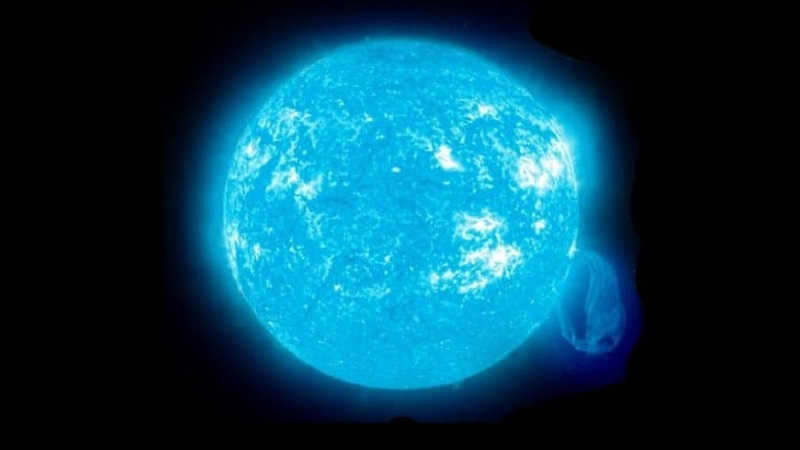
Stars of Intermediate Mass
Undoubtedly, the mass of a star plays a crucial role in its evolutionary path. Scientists have made notable progress in understanding how stars with various mass values proceed through their lifecycle.
- When a star has a mass equal to or less than 0.4 times the mass of our Sun, the ignition of helium does not take place. Instead, at the end of the hydrogen-burning phase, the outer shell is shed, leading to the formation of a white helium dwarf.
- For stars with a mass greater than 0.4 times that of our Sun, helium ignites in the core. This causes a decrease in internal pressure, resulting in a decrease in luminosity, and the star moves along the evolutionary path known as the horizontal branch.
- It turns out that a star that has completed the red giant stage is known as a white dwarf.
The significant mass

However, when their mass exceeds 12 solar masses, their luminosity increases even further. At this point, they are classified as supergiants. Within these supergiants, synthesis occurs involving heavier elements, including up to iron. This leads to the formation of an iron core, which eventually collapses or explodes as a supernova. The end result can be a neutron star or a black hole.
The Schoenberg-Chandrasekar limit is the maximum nuclear mass value at which no nuclear reactions can occur. Once this limit is reached, the star is unable to support its outer shell.
Enormous stars, their names and instances
As per stargazers, the gigantic variety incorporates Arcturus, Antares, Pollux, and others. It’s important to note that the well-known star Aldebaran is a supergiant.
For instance, the colossal red agent of the class is situated in the constellation of China, which is the renowned Mira. Or Tuban in the mythical serpent constellation, which is a white luminary.
Obviously, that isn’t all. Truth be told, there are a ton of them, and it likely doesn’t bode well to list them in a line.
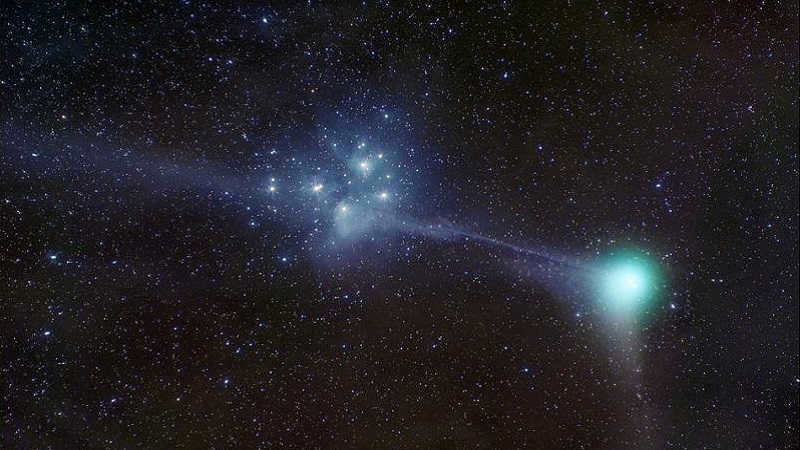
Therefore, we have gained knowledge regarding not just colossal stars, but also supergiants.
Each dazzling star is not merely an exquisite facade. The description of any of these stars is highly intriguing and also reveals a plethora of characteristics and life paths.
Furthermore, the examination of an individual celestial object or clusters of them plays a crucial role in comprehending the organization of our universe.
It is fascinating to observe and explore their peculiarities. The vast and captivating universe holds even more unfathomable wonders!
A red giant is a star belonging to the late spectral classes, boasting high luminosity and extended envelopes. Some examples of red giants include Arcturus, Aldebaran, Hakruks, and Mira A.
Red giants and supergiants possess immense sizes and consequently possess large surface areas. The distinctive radius of red giants ranges from 100 to 800 solar radii, which equates to a surface area 104 to 106 times that of the sun’s radius. Despite their name, red giants emit light that is not red, but rather an ochre-yellowish hue, similar to the color emitted by incandescent lamp coils, due to the fact that the temperature of their photosphere is close to that of the coil (≈3000 K).
The spectra of red giants are characterized by the presence of molecular absorption bands, as some molecules are stable in their relatively cold photosphere. The emission is highest in the red and infrared regions of the spectrum.
Red Giants: Young vs Old
During their lifecycle, stars can go through two distinct stages where they reach late spectral classes and high levels of luminosity: the formation stage and the later stages of evolution.
The point at which a young star transitions into a red giant is determined by its mass. At this stage, the star emits radiation as a result of the gravitational energy released during compression. As the star contracts, the surface temperature increases, but due to the decrease in size and radiating surface area, the overall luminosity decreases. Eventually, the star’s core begins the process of thermonuclear fusion, converting helium from hydrogen through the proton-proton cycle (and for massive stars, the CNO-cycle). This marks the star’s entry into the main sequence.
In contemporary astrophysics, the term red giants typically refers to evolved stars that have transitioned from the main sequence; protostars that have not yet reached the main sequence are generally referred to as young stars.
Origin and structure
“Young” and “old”
During their evolution, stars can achieve late spectral classes and high luminosities at two different stages: the star formation stage and the later stages of evolution.
The specific stage at which young stars are observed as red giants is determined by their mass – this stage can last approximately 10^3 years for massive stars with masses of M.
Approximately 10M⊙ and ~108 years for low-mass stars with M≈ 0.5⊙. During this period, the star emits energy as a result of the gravitational energy released during compression. The surface temperature of these stars increases as they compress, while the luminosity decreases due to the reduction in size and radiating surface area. Eventually, the fusion reaction of helium from hydrogen begins in their cores (proton-proton cycle, and for massive stars also CNO-cycle), and the young star enters the main sequence.
In the later stages of stellar evolution, once the hydrogen fuel in their core is depleted and a “passive” helium core is formed, stars exit the main sequence and transition into the red giant and supergiant region of the Hertzsprung-Russell diagram. This phase lasts for approximately 10% of the total “active” lifespan of stars, which refers to the stages of their evolution when nuclear fusion reactions occur in their core. Main-sequence stars with masses of M
< 10
M
⊙ stars with a mass less than 10 solar masses turn first into red giants and then into red supergiants; stars with
M
> 10
M
⊙ directly become red supergiants. Prior to entering the red giant stage, a star goes through an intermediate stage known as the subgiant stage. A subgiant is a star whose core has already ceased hydrogen thermonuclear reactions, but helium burning has not yet started due to insufficient heating of the helium core.
In the field of modern astrophysics, the term red giants
generally refers to evolved stars that have departed from the main sequence; young stars that have not yet left the main sequence are typically called protostars or by a specific type, such as T Taurus-type stars.
The protoplanetary nebula known as the Red Rectangle is the result of a red giant star ejecting gas and dust in an asymmetric manner.
Both young and old red giants exhibit similar observable characteristics due to their internal structure, which includes a hot and dense core surrounded by a sparse and extended envelope. The presence of this extended and relatively cold envelope causes a strong stellar wind, resulting in significant mass loss of 10-6-10-5M⊙ per year. Various factors contribute to the intensity of this stellar wind:
- The high luminosity of red giants, combined with the vast size of their atmospheres (with radii of 102-103R
⊙), results in the radiation pressure on the gas and dust in their envelopes being equal to the gravitational forces at the boundaries of their photospheres, causing the expulsion of matter. - The ionization of the regions of the shells beneath the photosphere makes them mostly opaque to electromagnetic radiation, leading to the convection mechanism of energy transfer. This is similar to solar activity, but in the case of red giants, the power of convective fluxes must be much greater than that of the Sun.
- Instabilities can arise in extended stellar envelopes, resulting in strong oscillatory processes accompanied by changes in the star’s thermal regime. The Red Rectangle Nebula’s photograph clearly shows density waves of matter ejected by the star, which may be a consequence of these oscillations. Periodic oscillations of the envelope can often be observed from great distances, as many “old” red giants are pulsation variables (see below), and even some “young red giants” like T Taurus display variability.
Convective mechanisms can transport nucleosynthesis products from internal nuclear sources to the star’s atmosphere, leading to observed anomalies in the chemical composition of red giants, such as elevated carbon content.
The density of red giants is significantly lower than that of water, with the average density being about a million times less. For comparison, the average density of the Sun is approximately equal to that of water, at 1 g/cm3. The ratio of average density to core density in red giants can be as high as 1:108, whereas the Sun’s ratio is around 1:50. The core of a red giant accounts for only about 10% of its total mass, where thermonuclear reactions occur. The majority of the star’s mass is found in a vast shell that extends outward from the core, acting as a conduit for the energy released in the core and transporting it to the surface.
The composition of red giants
The observable features of both “young” and “old” red giants can be attributed to their internal structure, which is characterized by a hot and dense core surrounded by a sparse and extended shell. These red giants are known to have a long and relatively cold envelope, which results in a strong stellar wind. The outflow of matter during this process leads to significant mass losses, estimated to be between 10-6 and 10-5 times the mass of our Sun per year.
The density of red giants is on average a million times lower than that of water, while the density of the Sun is approximately equal to that of water, 1 g/cm3. The ratio of average density to core density can be as low as 1:108, whereas for the Sun it is about 1:50. Around 10% of the mass of a red giant is concentrated in its small core where thermonuclear reactions take place, while the majority of the star’s mass is distributed in a long shell that transports the energy released in the core to the surface.
During the progressive development of stars on the main sequence, the depletion of hydrogen occurs, resulting in the synthesis of helium through the pp-cycle and, for more massive stars, the CNO-cycle. This depletion process causes an accumulation of helium in the central regions of the star, where the temperatures and pressures are not yet sufficient for thermonuclear reactions to take place. As a result, the energy release in the stellar core ceases, leading to compression and subsequently causing a rise in temperature and density. This increase in temperature and density triggers a new source of thermonuclear energy: the depletion of helium through the triple alpha process. This process is characteristic of red giants and supergiants.
Red giant Author: astroson.com 2017-04-20
Red giants exhibit variability
Shown here is an ultraviolet photo of Mira, a red giant star. The elongated shape of its atmosphere is caused by the gravitational influence of its companion star.
- Mirids are a type of red giant star that pulsate radially with long periods, ranging from 80 to over 1000 days. They have variations in brightness from 2.5 magnitudes to 11 magnitudes and exhibit emission lines in their spectra.
- SR stars are another type of red giant star that pulsate semi-regularly with periods ranging from 20 days to several years. They have light variations of approximately 3 magnitudes. An example of an SR star is Z Ursae Majoris.
- SRc stars are semi-regular pulsating supergiant stars of spectral class M. Examples of SRc stars include Mu Cephei, Betelgeuse, and Alpha Herculis.
- Lb stars are irregular slow pulsating variable giants of spectral classes K, M, C, and S. An example of an Lb star is CO Cygni.
Red Giant Stage of the Sun

The Sun’s life cycle
The Sun is presently in its middle age as a star, with an estimated age of around 4.57 billion years. It will continue to stay on the main sequence for another 5 billion years, gradually increasing its luminosity by 10% every billion years, until the hydrogen in its core is exhausted.
Following this, the solar core will experience a significant increase in temperature and density, leading to the ignition of helium and its subsequent transformation into carbon. As a result, the Sun’s size will expand by at least 200 times, nearly reaching the Earth’s current orbit (0.93 a.u.)[3][4][5]. Despite the Sun’s substantial mass loss during its transition to the red giant phase, Mercury and Venus will be engulfed and completely vaporized. If Earth manages to escape this fate, it will be subjected to intense heating, making the preservation of life impossible[6][7]. The oceans will evaporate long before the Sun enters its red giant phase, approximately 1.1 billion years from now[8].
After spending around 100 million years in the red giant phase, the Sun will transform into a planetary nebula featuring a white dwarf at its core. This mesmerizing nebula will gradually disperse into the vast expanse of the interstellar medium over the course of a few millennia, while the white dwarf itself will undergo a gradual cooling process that can last anywhere from several billion to a mind-boggling 100 quintillion years.
A red giant, also known as a supergiant, is a type of astronomical object that has an expanded envelope and emits high levels of light. These objects are classified as late spectral classes K and M. Red giants have radii that are hundreds of times larger than the radius of the sun. They emit the most light in the infrared and red regions of the electromagnetic spectrum. On the Hertzsprung-Russell diagram, red giants are positioned above the main sequence line, and their absolute stellar magnitude ranges from slightly above zero to negative values.
The size of this star is at least 1500 times larger than the Sun, while its diameter is approximately 40 times greater. Due to the absolute magnitude difference of around five with our star, the red giant emits about a hundred times more light. However, it is also significantly colder. The temperature of the red giant is half that of the Sun, resulting in the luminary of our system emitting sixteen times more light per unit surface area.
The surface temperature of a star is directly responsible for the color that it appears to us. The Sun, for example, is quite hot and has a relatively small size, which is why we refer to it as a yellow dwarf. Stars that are cooler than the Sun emit orange and red light. As a star evolves, it can go through different spectral classes and eventually become a red giant at two different stages of its development. This transformation can occur either during the initial formation of the star or during its final stages of evolution. During this time, a red giant star begins to release energy as a result of its own gravitational compression.
As the star undergoes contraction, its temperature rises, while its luminosity decreases significantly due to surface shrinkage. This leads to a gradual fading of the star. In the case of a young red giant, a thermonuclear fusion reaction of hydrogen and helium will eventually initiate in its core, causing the star to enter the main sequence. However, older stars have a different destiny. As they approach the later stages of their evolution, the hydrogen within their cores is completely depleted, causing the stars to transition away from the main sequence. In the Hertzsprung-Russell diagram, they then move into the region occupied by supergiants and red giants. Prior to reaching this stage, however, they pass through an intermediate phase known as a subgiant.
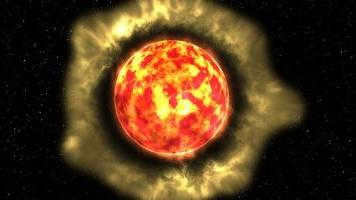
Arthur is a star with a brightness level of -0.1. Situated at a distance of approximately 36 to 38 light-years from the Sun, it is observable in the Northern Hemisphere during the month of May when looking directly towards the south. In terms of size, Arthur is 40 times larger than our Sun.
Our Sun, also known as a yellow dwarf, is relatively young, with an estimated age of 4.57 billion years. It is predicted to remain on the main sequence for another 5 billion years. However, scientists have developed a model depicting a future scenario where the Sun transforms into a red giant. During this phase, its size will expand by 200 times, eventually engulfing the orbits of Mercury and Venus. Consequently, life on Earth will become impossible. This red giant stage is expected to last for approximately 100 million years, after which the Sun will evolve into a planetary nebula and eventually become a white dwarf.
Understanding the Appearance of Giant Stars and Celestial Evolution
Astronomers have a wealth of knowledge about various types of stars, ranging from hot to cold and large to small. These celestial objects are classified based on their absolute magnitudes and spectral characteristics. The spectrum not only reveals the temperature of these objects but also provides insights into their chemical composition.
Check out our article on The Melting Point of Osmium
Also, don’t miss: Exploring the Constellation Veronica’s Hair – Main Stars and Interesting Objects to Observe – Discovering the History of Veronica’s Hair – The Fascinating Constellation of Veronica’s Hair
In 1910, two scientists, Einar Herzsprung and Henry Russell, independently created a diagram that greatly simplifies the classification of stars and provides a clear representation of their developmental stages. Furthermore, it effectively demonstrates the interdependence of spectral class, stellar magnitude, and luminosity.
On this diagram, stars are not randomly arranged, but instead form distinct areas. The majority, 90% of all stars, fall within the main sequence area. Additionally, there is a section on the diagram dedicated to red giants and supergiants, which house stars in their final stage of evolution.
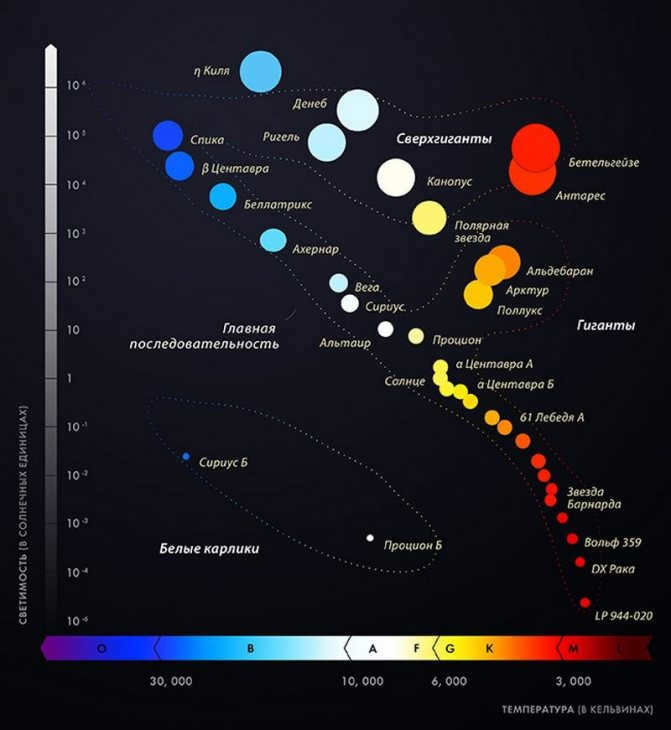
The Hertzsprung-Russell diagram illustrates the different stages of a star’s life cycle. The majority of stars follow a main sequence, where they derive their energy from reactions in their central region. These reactions include the proton-proton cycle and the CNO cycle for more massive stars. Once the thermonuclear reactions cease, a helium core forms and the star transitions into a red giant.
The fate of a star depends on its mass. If the star is less than ten times the mass of the Sun, it will evolve into a red giant and then a supergiant. On the other hand, if the star is more massive, it will immediately become a supergiant. There is also an intermediate stage called the subgiant stage, where helium burning has not yet started and fusion in the hydrogen core has ceased.
